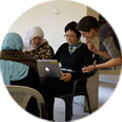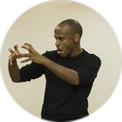Decoupling of Pointing and Gaze in Israeli Sign Language and Gesture:
Emergence of an Abstract/Concrete Reference Distinction
Kate Meshi, Svetlana Dachkovskyii, Rose Stampiii and Wendy Sandleri
iUniversity of Haifa, iiGordon Academic College of Education, iiiBar Ilan University
One account of sign language emergence posits that pointing is first used with ‘concrete’ functions (e.g., indicating present referents), and only later develops ‘abstract' functions (e.g., anaphora). We present the first study to put this account to the test using data from a young sign language, Israeli Sign Language (ISL).
Study 1: We analyzed pointing in three generations of signers, whose signing can be understood to reflect the structure of ISL at different stages in its emergence. If ISL began with concrete pointing functions and later developed abstract ones, we should see the following in younger signers: (1) more points with abstract functions, and (2) evidence in the form of the pointing sign, showing that concrete and abstract pointing functions have diverged. Our findings provide just this evidence: relative to older signers, young signers produced more abstract points, and used the presence or absence of aligned eye gaze to more consistently distinguish concrete from abstract points.
Study 2: We compared the original signer group with a set of age-matched, non-signing Hebrew speakers. Speakers showed the same pointing behaviors across age groups: notably, speakers all tended to use point together with eye gaze for concrete reference, and for abstract reference they decoupled the two, using point only. Considering that speakers all have a fully conventionalized language that distinguishes concrete from abstract reference linguistically, we suggest that their gesture behavior is derived from this linguistic distinction. In a young sign language, the distinction must be forged over time, which is indeed what Study 1 attests. That the end of this process made the points of young signers more like those of speakers reveals that abstract pointing functions are common to users of full linguistic systems, whether spoken/gestural or signed.







